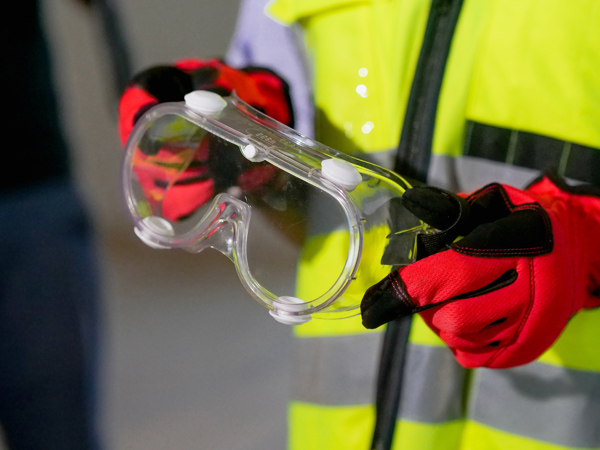
Because the natural refrigerant Ammonia is toxic in higher concentrations and highly flammable, safety is important. NH3 is classified as a B2L refrigerant It has been used for more than a century and is currently widely used in major industrial applications worldwide and is increasingly used in commercial refrigeration and air conditioning. As with all natural refrigerants, taking proper safety precautions and following instructions are important.
How to minimise the risks?
- Good basic safety procedures, good communication and well-trained personnel.
- Staff should always wear ‘Personal Protective Equipment (PPE)’ at all times (gloves, clothing eye and face protection). Equipment should always be checked before usage.
- Refrigerant handling Instructions must be regularly given.
- Technicians should never work alone with the refrigerant (a colleague can provide first aid in the case of an accident).
- Companies must draw up good policies on NH3.
- Engineering Practices should be developed and implemented.
- Never undertake any brazing, repair work, or other high-risk activities before the equipment has been completely and thoroughly cleaned.
- At least every five years or when there is a major change in the system a ‘Process Hazard Analysis’ (PHA) should be made to identify, control, and evaluate any potential danger. All identified issues can potentially cause an accidental ammonia release.
- Maintenance must be conducted and documented daily.
- Regular visual inspections offer insights into abnormalities that could lead to accidents, they are inexpensive but can eliminate high risks.
- Do regular thermal check ups in the system. This can detect hot spots that may cause failure before they can be seen.
- All tools and piping insulation must be inspected visually on regular basis.
- Selecting the right specialised equipment.
- Systems must be designed in a way that minimises the danger of a leak. All parts of the refrigeration circuit need to be hermetically sealed.
- The complete system should be secured from falling objects.
- NH3 cylinders must be carried only in specialised equipment to prevent cylinders from breaking. Only specialists should handle damaged cylinders. A regular technician should never open them.
- Forklifts, hand trucks, and other maintenance vehicles can cause damaging. Components should be protected. It is good practice to provide barriers or establish safety zones.
- Due to the refrigerant’s slight flammability, it must be kept away from ignition sources (hot surfaces, sparks, electric switches, etc).
- Ventilation must be installed in all areas where NH3 could leak. This prevents the refrigerant from reaching a dangerous concentration in the air. Installers should never work in unventilated areas.
- Ventilation and the exhaust openings must be placed the right way so that the airflow does not damage human health. Because lighter than air the ventilation openings must be placed near the ceiling.
- NH3 tends to form a cloud that stays near the ground for a short time. This is because it becomes a vapour upon release. However, it is lighter than air, meaning that it will disperse into the sky. To help this a good ammonia gas extraction installation might be useful.
- Wherever leaks can occur, special detectors must be installed, triggering an alarm with a reasonable sound level.
- Good communication and a business culture that focuses on learning from mistakes is crucial in reducing safety incidents.
The decisions made during the first 30 minutes of an emergency event are critical in protecting life and health and to stop the emergency event when it is still small.
- Ammonia has a distinctive odour, meaning that accidental releases can be noticed before the concentration in the air becomes dangerous to human health. Most people detect the smell at concentrations of 0.6 to 53 ppm. At 50 ppm, ammonia is already irritating. Most people experience immediate and severe irritation to the nose and throat at 500 ppm. Fatal injuries are possible at 1500 ppm.
- A person exposed to R717 should seek medical attention quickly, even though some symptoms may be delayed.
- Companies should have good information about the symptoms of exposure and how to provide first aid. Exposure may primarily affect the eyes, skin, or respiratory system. People should get special training.
- Anyone helping in a situation where the refrigerant was released accidently is advised to call a doctor or an ambulance immediately in all cases, and bring victims to a well-ventilated area, away from the source of exposure. The decontamination area should be upwind and uphill from the site. It should also include two warm zones, one for entering and one for leaving.
- A person giving first aid must wear ‘Personal Protective Equipment (PPE)’.
If all the right measures are taken, the refrigerant is safe to use. Frequent checks, protecting systems from external damage, alarm system and a company culture that encourages reporting mistakes and learning from them, are key points in the process. In case of an accidental release of NH3 the first steps are crucial, and training is key. Accidents with R717 are extremely rare in relation to the volume of the refrigerant handled globally on daily basis. The best way to protect the workforce from injuries related to accidental ammonia releases is to prevent incidents in the first place by ensuring the right level of qualifications and training for all staff involved in the design, operation and maintenance of the plant and those people giving first aid.


